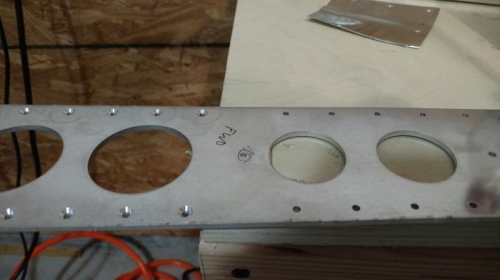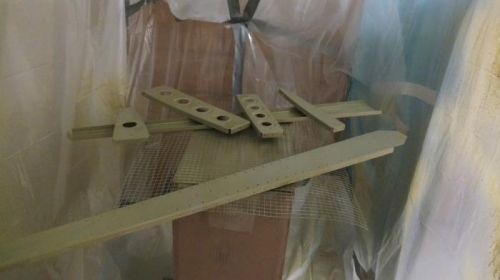
|

|
|

|
Tibbo's RV-14 Hobby

|
Date: 2-20-2016
|
Number of Hours: 5.00
|
Manual Reference:
|
Brief Description: First time priming
|

|
Today I finished countersinking the holes on the vertical stabilizer stiffener. With that, the only thing left to do is prime, dimple, and rivet. Because the primer can flex with the metal during dimpling (but won't remain in place during countersinking), I opted to prime first.
My priming method is PreKote then AKZO Nobel 2-part epoxy primer.
PreKote is an environmentally friendly soap-like liquid that deep cleans the metal and leaves it "sticky" on a microscopic level to prepare for follow-on primer adhesion. There's lots of ways to prep the metal, some involve acid-etching, some involve toxic alodine, but PreKote is about as hazardous as shampoo. In fact, it's EPA recommended and 100% non-toxic and 100% bio-degradable. So I was able to do the PreKote steps in the shower. Using a 3M Maroon Scotchbrite scrubbing pad, I worked the PreKote into a lather, scrubbed vertically, reapplied without rinsing, scrubbed horizontally, then sprayed it off with the shower head. The liquid was noticably dirty, and the metal had lost its "Alclad" sheen. It was ready.
I then went back to my shop to spray the primer. A lot of the time spent in the shop today involved mixing/inducting the primer, calibrating the spray gun, and testing on a scrap piece. First step, mix the epoxy and hardener in a 1:1 ratio, then mix, then let it sit for its 30 minute induction time. Induction, with epoxy, is letting the two pieces undergo their exothermic chemical reaction and bond to make the full primer solution, ready for spraying. It won't harden in the spray gun for at least 8 hours, yet will dry once sprayed in 15 minutes.
I brought in a test piece to experiment on first, and this is where most of the time tonight went, to include mixing and inducting a second batch.... Once I was finally happy with that, I sprayed the rest of the pieces shown below. I decided to let the pieces cure on a piece of chicken wire to provide minimal surface area to contact, and set that chicken wire on a cardboard box. I stopped when I ran out of primer
|

|

Counter-sunk holes on stiffener
|

|

First primed pieces curing
|

|
|

|

|

|
|

|

|
Copyright © 2001-2024 Matronics. All Rights Reserved.
|

